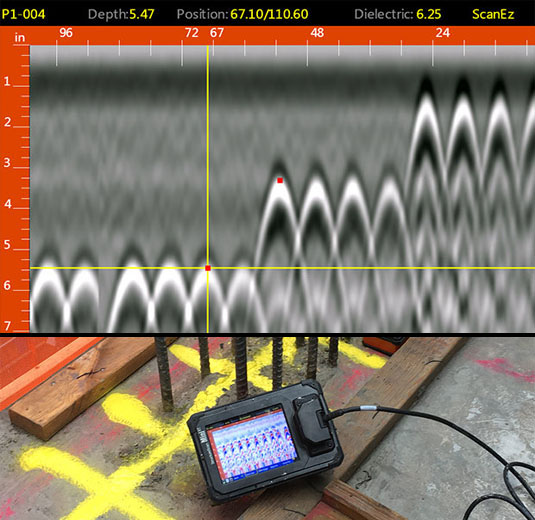Beyond the Surface: Leveraging Advanced Concrete Scanning Techniques for Unmatched Accuracy and Insight
Advanced concrete scanning methods have arised as crucial tools in this search, providing a glimpse under the surface to unveil a globe of important insights. By taking advantage of advanced modern technologies, experts can uncover abnormalities, evaluate the problem of concrete structures, and make educated decisions that form the program of tasks.
Value of Advanced Concrete Scanning
The significance of making use of advanced concrete scanning strategies lies in the unmatched precision they supply for discovering sub-surface abnormalities and guaranteeing architectural integrity. By using sophisticated innovations such as ground-penetrating radar (GPR), electro-magnetic induction, and advanced finder imaging, construction professionals can delve beneath the surface area of concrete structures with a degree of precision that much goes beyond typical examination methods. Concrete Scanning. These strategies make it possible for the identification of surprise dangers like rebar rust, spaces, avenues, or post-tension cable televisions that might endanger the stability and safety and security of a framework with time
Moreover, advanced concrete scanning gives very useful insights into the total problem of a concrete element without the requirement for intrusive measures, decreasing the risk of creating damage throughout the analysis process. The capacity to pinpoint the specific location and depth of potential issues enables targeted fixings and maintenance, inevitably extending the lifespan of the structure and optimizing its efficiency. Basically, the significance of advanced concrete scanning can not be overstated in the realm of building and facilities maintenance, where precision and reliability are critical.
Sorts Of Cutting-Edge Technologies

Abnormalities and Issue Detection

Along with GPR, concrete scanning strategies like thermography and impact-echo screening are also efficient in finding problems and anomalies. Thermography uses infrared modern technology to recognize variants in surface area click for source temperature, indicating potential areas of issue such as delamination or wetness access. On the various other hand, impact-echo screening entails assessing acoustic feedbacks to detect voids, cracks, and other problems within the concrete. By leveraging these advanced techniques, experts can proactively deal with structural problems, guaranteeing the durability and security of concrete structures.
Assessing Concrete Problem
How can engineers properly examine the problem of concrete frameworks to ensure their longevity and safety and security? Analyzing the concrete problem is a crucial element of keeping framework honesty. Different sophisticated concrete scanning techniques are employed for this objective. Ground-penetrating radar (GPR) is frequently used to assess the inner structure of concrete, discovering voids, splits, and other anomalies that might jeopardize its link strength. Furthermore, impact-echo testing can give understandings into the density and stability of concrete components. Ultrasonic pulse speed testing is an additional important approach for examining concrete quality by gauging the speed of audio waves with the product.
Furthermore, aesthetic inspection stays a basic part of concrete condition analysis. Engineers visually check out the surface for indications of damage, such as spalling, breaking, or staining. Incorporating non-destructive testing techniques with aesthetic inspections enables for a detailed analysis of concrete condition, allowing designers to recognize potential issues early and apply timely maintenance or repair services. By leveraging these innovative techniques, engineers can guarantee look what i found the long-lasting durability and safety of concrete structures.
Enhancing Decision-Making Procedures
In the world of facilities administration, enhancing decision-making processes is crucial for making sure the efficient maintenance and longevity of concrete structures. Enhanced decision-making procedures in concrete monitoring include using sophisticated scanning techniques to gather thorough information on the problem of frameworks. By leveraging innovations such as ground-penetrating radar and 3D imaging, stakeholders can make enlightened choices relating to substitute, repair service, or reinforcement strategies.
These progressed scanning methods offer important insights right into the internal make-up of concrete, determining prospective concerns such as spaces, cracks, or deterioration that might not be visible externally. This level of detailed details enables for proactive upkeep planning, minimizing the threat of structural failings and enhancing the total life expectancy of concrete structures.
Furthermore, by incorporating electronic documentation and evaluation tools right into the decision-making process, stakeholders can track the advancement of concrete conditions with time, allowing anticipating maintenance methods and optimizing source allocation. Eventually, the integration of sophisticated concrete scanning strategies improves decision-making procedures by providing unequaled precision, insight, and performance in infrastructure administration.
Verdict
Finally, progressed concrete scanning strategies provide unmatched accuracy and insight in identifying anomalies, flaws, and analyzing the condition of concrete structures. By leveraging innovative modern technologies, decision-making processes can be improved, bring about even more informed and effective solutions for preserving and fixing concrete framework. These strategies play an essential function in making sure the safety and security and longevity of concrete structures, making them an important device in the area of building and construction and design.
Moreover, advanced concrete scanning offers vital understandings right into the total problem of a concrete component without the demand for intrusive measures, minimizing the risk of causing damage during the assessment process - Concrete Scanning. Another innovative technology is 3D X-ray scanning, which offers comprehensive images of the internal structure of concrete, offering valuable information without the need for destructive screening. In Addition, Concrete Cover Meters are made use of to gauge the density of concrete cover over support bars accurately. Enhanced decision-making processes in concrete monitoring entail making use of sophisticated scanning methods to gather detailed information on the condition of frameworks.In conclusion, progressed concrete scanning strategies use unequaled precision and insight in spotting anomalies, issues, and analyzing the problem of concrete structures
Comments on “Effective Concrete Scanning Approaches for Construction Tasks”